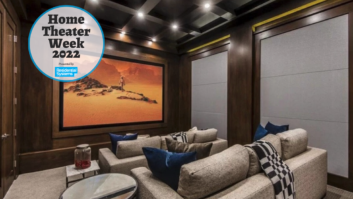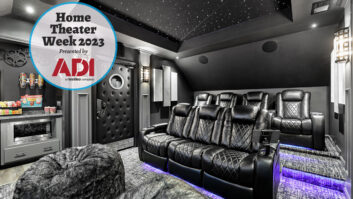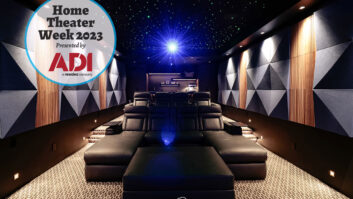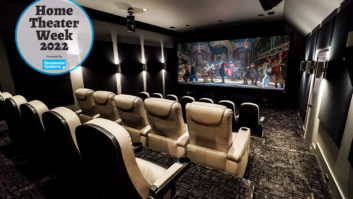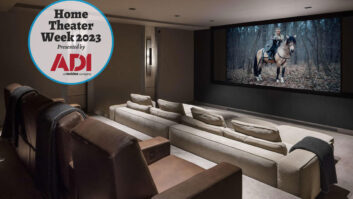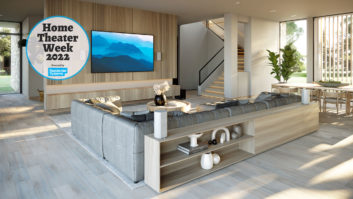The most important thing that I have been reminded of during my quest to create a real home theater is that at a certain price point, home theater products are no longer conducive to do-it-yourselfers like me. Believe me, Ive always preached the value of the custom installation channel; its what we do as a magazine. But when it came time for me to build my own system, two issues made me shy away from calling in the big guns: I was too cheap, and I valued your time and money too much to ask for pro bono installation work. It almost came back to bite me.

With the help of my stepdad, Victor, building the screen was relatively easy.
Thus far Im very proud of what Ive learned. To start things off, my stepdad and I installed my 120-inch projection screen from the good folks at Screen Research and built shelves for my Niles StageFronts. As I wrote in my February column, our screen installation went a bit against the grain as we had to build our own support frame three feet out from the wall to accommodate the shelves holding my left, center, and right Niles StageFront loudspeakers. In retrospect, I would have been less liberal with that distance from the wall, but I thought I might want to walk back there and between the speakers and the screen. What I later realized was that as long as I could duck under the speaker shelves, I would be OK. Two feet would have been sufficient.

The shelves aren’t fancy and the screen is too far forward, but the Niles StageFronts sound fantastic coming through the acoustically transparent, woven screen from Screen Research.
My next misstep was positioning the screen too low on the frame. This should have been a simple fix when my dad and step mom came over one Saturday, but we made it harder that it should have been. When my stepmom finally realized that we could simply drill new holes in the steel screen structure, instead of trying to match up holes that were previously drilled with new holes in the wooden frame, our three-hour excursion was over.

Too low! The initial screen height wasn’t quite right, but the frame we built was solid.
My proudest moment thus far was re-learning how to use a sewing machine and taking remnant fabric from a local sewing store and finishing the wooden frame around the screen. I thought that the drapes on the sides would be done at a much later date due to lack of financial resources, but fortunately Dad showed up with unused scraps of the old black velvet stage curtain from the high school where he teaches and runs the performing arts center. A little cutting and hemming and they looked amazing.

Remnant fabric and Grandma’s sewing machine did the trick here.
On that same visit, Dad loaned me a temporary mount for my new Runco RS-1100 Ultra with AutoScope. Remember the old AV carts from high school? He brought me one of those so I could at least use the RS-1100 while looked for time to mount it properly and have it calibrated.
Speaking of Runco, when I found out that Runco would be able to send me a loaner unit for my new theater space, I thought it would be a simple matter of picking something from their line that I liked (720p with anamorphic lense would be a good match to my masking screen) and having them ship it out. Only later did I learn about all of the math that goes into picking the proper lenses for my throw distance, etc., and the custom building that Runco does to its projectors before sending one out. Bob Grubbs at Runco blew my mind with his calculations over the phone, but I trusted him and he got me something even better than I had asked for originally. Now I get to play with a 1080p projector (once I get my hands on a Blu-ray player), and the throw distance is on the money. I couldnt be happier with the results.

Niles StageFront surrounds. Look Ma, no wires showing!
Before I talk more about the video side, I need to backtrack a bit in my chronological order of installation. For almost the entire eight months that Ive lived in my new house, Ive had my Niles StageFronts connected via basic speaker wire to a Sunfire Theater Grand Receiver. Only after I got my screen finished did I run proper, fire-rated Tributaries speaker wire and mono subwoofer cable across my drop ceiling and down the wall to my fronts and surrounds. Not owning the proper install tools led me to fabricate some new rigs of my own with metal clothes hangers. It was harder that it should have been, but it eventually did the trick and my wires are hidden.
Turning to the set-up on my Sunfire receiver, I was initially a bit intimidated. For instance I couldnt figure out how to get the enormous Niles subwoofer working. A quick call to Eric Harper in Lexington, Kentucky, however, provided me with the proper button pushes, and I was soon listening to the most amazing theater audio Ive ever heard in my own home. It turns out that if I had just take taken the time to read the manual, the functionality of the TGR would have been pretty simple. Inputs are not infinitely assignable, so there really arent a lot of ways to get yourself in trouble. It did take me a while to realize that some of the LEDs on the front panel are actually function buttons. This is something Harper admitted has caused confusion for others, and has been changed on the new receiver and processor models.

Ken Whitcomb donated his calibration time. Note the rockin’ high school AV cart. Thanks Dad! Of course, I couldnt wait to get my video and audio working together. Fortunately I was able to convince Ken Whitcomb, an Indianapolis-based Runco calibration professional, to drop by and enable some of the calibration functions on the projector and to make the anamorphic lense fully operational. Along the way, he discovered that I had mounted the anamorphic lense sideways and that the software from the factory was set up for a fixed anamorphic lense instead of one using AutoScope. Ken called Runco, had them e-mail him the file and once that was uploaded to my projector, we were in business. A few tweaks later, Ken determined that the picture definitely does not suck. Ken was pleased, and I was quite happy, to say the least.
Next, I connected my new OPPO DV-980H DVD Player, which Ive found to be a low-cost, yet well designed upconversion option for your friends and family. Like all less-expensive DVD players, it has its lock-up moments, but so far those have been few and far between. Time will tell and Ill provide a deeper analysis in the March issue of the magazine. Suffice it to say, the picture a 2.35:1 Lord of the Rings DVD looked as close to Blu-ray as I can get for now. And the fact that I can play SACD and DVD Audio is a fun retro feature that Ill play with once I get my demo disks back from a friend who had a player before I did.
In case youre wondering, my other source of video content is HD cable from my local provider. Fortunately I was assigned the only well-trained cable company installer that Ive ever met, and he was able to tweak the system for the best picture.
Like most of you, I had a Super Bowl Sunday deadline to meet. My youngest brother and his girlfriend were coming over, and I really wanted to get the projector mounted in my back storage room and cut a portal window in the wall to achieve the proper throw distance to fill the screen.

It’s rough now, but wait until I get done using my new miter box.
One long Saturday night later and the mission was accomplished. Not only did I discover how cool the Peerless PRG mount design really is, I also found out that I could cut drywall without fear (when those pesky studs dont get in the way!) The Peerless mount really surprised me because it wasnt a bulky mount, yet it could accommodate my very large Runco projector with no fear of falling down. Also, its adjustments were simple to learn, enabling me to tweak my tilt, level, and yaw with no headaches.

Peerless’s PRG mount was a solid performer.
I still have some finish work to do, like mitering a frame to place around the hole the wall and closing up the ceiling tile above the projector, but its getting close. Next up is programming my touch panel from RTI, hanging some curtains in a window and re-painting the room. Who knows? I may even add theater seating and a starry ceiling at a later date. Stay tuned on those.
Before I end my rambling blog, Id like to thank several people for helping me pull the pieces together on this project so far:
Runco/Planar: Rick Bergamaschi, Pippa Edelen, Scott Hix, Bob Grubbs, and Katie Short (Caster Communications PR)
Niles Audio: Frank Sterns, Mike Detmer, and Coleen Sterns Leith (Marketing Matters PR)
Screen Research: John Caldwell and Kevin Leja (StJohn Group), Peter Hoagland (PR) and Jim McGall
Sunfire: Eric Harper and Peter Hoagland (PR)
Tributaries: Joe Perfito and Sue Toscano (Nicoll PR)
Peerless: Viktorya Maryan
And last but not least, thanks to Victor Dorsten, Joe Glowacki, Leslie Glowacki, Todd Glowacki, and Chris Glowacki for their free labor!
